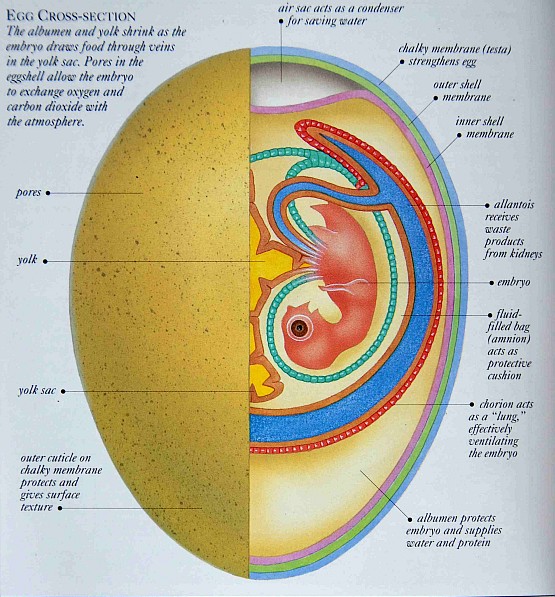
Last week we examined a newly laid bird’s egg. This week things get more complicated.
Eggs are tiny incubation chambers with all the tools needed to transform an embryo into a baby bird. The right temperature gets the process rolling.
As an egg is incubated the embryo changes and the membranes take on the critical functions of respiration, circulation and excretion. The yolk and albumen shrink as they’re consumed and the shell participates in respiration and bone construction.
This illustration by Stuart Lafford, from Birds’ Eggs by Michael Walters, shows what’s going on inside.
- The embryo, surrounded by the amnion, floats in a fluid cushion.
- The yolk is attached to the embryo’s belly and shrinks as its food is consumed.
- The allantoic sac acts like a sewer collecting excretion from the embryo. It also functions in respiration because it’s pressed against the chorion for air exchange.
- The chorion supports all the embryonic structures and acts like a lung, exchanging oxygen and carbon dioxide through the shell’s pores.
- The shell thins as the baby bird takes up calcium to construct its bones. The thinning allows for increased air exchange so the growing embryo receives more oxygen. It’s also easier to break the thinner shell at hatch time.
In a matter of weeks the egg contains a baby bird, and then he breaks the shell.
The egg has fulfilled its role as an incubation chamber.
(illustration by Stuart Lafford from Birds’ Eggs by Michael Walters, published by Dorling Kindersley, 1994, used by permission. Click on the image to visit Stuart Lafford’s website. This “Tenth Page” article is inspired by page 425 of Ornithology by Frank B. Gill.)